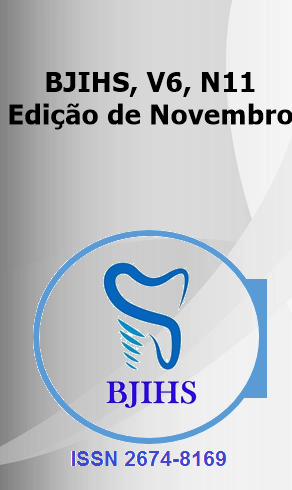Abstract
O HIV (Vírus da Imunodeficiência Humana) continua sendo um dos maiores desafios da saúde pública global, afetando milhões de pessoas em todo o mundo. Embora a terapia antirretroviral (TAR) tenha prolongado significativamente a vida de indivíduos infectados, ela não é capaz de erradicar o vírus devido à existência de reservatórios virais latentes, nos quais o DNA proviral do HIV permanece integrado ao genoma das células hospedeiras. A tecnologia CRISPR-Cas9, uma ferramenta de edição gênica de alta precisão, oferece uma nova abordagem para enfrentar essa limitação, permitindo a remoção direta do DNA proviral ou a modificação de genes essenciais para a entrada e replicação do HIV, como o CCR5 e o CXCR4. Este artigo revisa os avanços recentes na aplicação do CRISPR-Cas9 no controle do HIV, com ênfase na excisão do DNA proviral, na modificação de genes do hospedeiro fundamentais para a infecção e na eliminação dos reservatórios virais latentes. A aplicação do CRISPR-Cas9 tem demonstrado resultados promissores em estudos pré-clínicos, reduzindo significativamente a carga viral e inativando o HIV em modelos celulares e animais. Avanços no desenvolvimento de variantes mais precisas da enzima Cas9, sistemas de entrega aprimorados e abordagens combinadas com outras terapias, como a reativação de reservatórios latentes e a imunoterapia, oferecem novas perspectivas para superar essas barreiras. A tecnologia CRISPR-Cas9 tem o potencial de revolucionar o tratamento do HIV, mas sua implementação clínica ainda requer refinamentos técnicos e a solução de questões éticas, particularmente no que diz respeito à edição genética humana. Este artigo explora os progressos, limitações e futuras direções dessa abordagem, discutindo o papel que essa tecnologia pode desempenhar no caminho para a erradicação do HIV.
References
ACOSTA-SOTO, America Fernanda et al. Fundamentals of CRISPR-Cas9: Gene-editing technology and basic. GSC Advanced Research and Reviews, v. 20, n. 1, p. 042-049, 2024.
ALUM, Esther Ugo et al. Toward a cure–Advancing HIV/AIDs treatment modalities beyond antiretroviral therapy: A Review. Medicine, v. 103, n. 27, p. e38768, 2024.
ARMANI-TOURRET, Marie et al. Immune targeting of HIV-1 reservoir cells: a path to elimination strategies and cure. Nature Reviews Microbiology, p. 1-17, 2024.
BASAR, Emre et al. Biological Barriers for Drug Delivery and Development of Innovative Therapeutic Approaches in HIV, Pancreatic Cancer, and Hemophilia A/B. Pharmaceutics, v. 16, n. 9, p. 1207, 2024.
BHIA, Iman et al. CRISPR/Cas9 from Discovery to Clinical Impact: A Comprehensive Review of History, Mechanisms, Applications, and Future Challenges. Authorea Preprints, 2024.
CHRISTOPOULOS, Katerina A. et al. First demonstration project of long-acting injectable antiretroviral therapy for persons with and without detectable human immunodeficiency virus (HIV) viremia in an urban HIV clinic. Clinical Infectious Diseases, v. 76, n. 3, p. e645-e651, 2023.
GERETTI, Anna Maria et al. Outcomes of coronavirus disease 2019 (COVID-19) related hospitalization among people with human immunodeficiency virus (HIV) in the ISARIC World Health Organization (WHO) clinical characterization protocol (UK): a prospective observational study. Clinical Infectious Diseases, v. 73, n. 7, p. e2095-e2106, 2021.
GOEL, Rajeev. CRISPR/Cas9-mediated genome editing: from basic research to gene therapy. International Journal of Research in Medical Sciences, v. 12, n. 6, p. 2200, 2024.
GUIZAR, Paola et al. An HIV-1 CRISPR-Cas9 membrane trafficking screen reveals a role for PICALM intersecting endolysosomes and immunity. Iscience, v. 27, n. 6, 2024.
HUSSEIN, A.; ABRAHA, B. Bacterial CRISPR/Cas9 system as discovery of promising solutions for all health problems and advancement in bioengineering. Int J Mol Biol Open Access, v. 7, n. 1, p. 49-56, 2024.
KHOSHANDAM, Mohadeseh et al. Clinical applications of the CRISPR/Cas9 genome-editing system: Delivery options and challenges in precision medicine. Genes & Diseases, v. 11, n. 1, p. 268-282, 2024.
KIM, Minse et al. Advances in Nanoparticles as Non-Viral Vectors for Efficient Delivery of CRISPR/Cas9. Pharmaceutics, v. 16, n. 9, p. 1197, 2024.
KLINNERT, Sarah et al. Targeted shock-and-kill HIV-1 gene therapy approach combining CRISPR activation, suicide gene tBid and retargeted adenovirus delivery. Gene Therapy, v. 31, n. 3, p. 74-84, 2024.
LINDEGGER, Daniel Josef. Advanced Therapies for Human Immunodeficiency Virus. Medical Sciences, v. 12, n. 3, p. 33, 2024.
LIN, Dong et al. Increased efficiency for biallelic mutations of the CCR5 gene by CRISPR-Cas9 using multiple guide RNAs as a novel therapeutic option for human immunodeficiency virus. The CRISPR Journal, v. 4, n. 1, p. 92-103, 2021.
NIELSEN, Ian Helstrup et al. Cell-targeted gene modification by delivery of CRISPR-Cas9 ribonucleoprotein complexes in pseudotyped lentivirus-derived nanoparticles. Molecular Therapy-Nucleic Acids, v. 35, n. 4, 2024.
PAYRA, Shuvasree et al. HIV cure: Are we going to make history?. HIV medicine, v. 25, n. 3, p. 322-331, 2024.
ROHLFES, Nicholas et al. The nuclear localization signal of CPSF6 governs post-nuclear import steps of HIV-1 infection. bioRxiv, p. 2024.06. 20.599834, 2024.
SAIFULLAH, M. et al. The CRISPR-Cas9 induced CCR5 Δ32 mutation as a potent gene therapy methodology for resistance to HIV-1 variant: a review. European Review for Medical & Pharmacological Sciences, v. 28, n. 6, 2024.
SCHMIDT, Jenna Kropp et al. CRISPR/Cas9 genome editing to create nonhuman primate models for studying stem cell therapies for HIV infection. Retrovirology, v. 19, n. 1, p. 17, 2022.
VASCONCELOS KOMNINAKIS, Shirley et al. CRISPR/CAS as a Powerful Tool for Human Immunodeficiency Virus Cure: A Review. AIDS Research and Human Retroviruses, 2024.
ZAHEDIPOUR, Farzaneh et al. Harnessing CRISPR technology for viral therapeutics and vaccines: from preclinical studies to clinical applications. Virus Research, v. 341, p. 199314, 2024.

This work is licensed under a Creative Commons Attribution 4.0 International License.
Copyright (c) 2024 Bernardo Coradi Burille, Hugo de Sousa Leal Neto, Milena Merino Machado, Davit Willian Bailo, Larissa Cattusso Casagrande
